






























It is no secret that we just came off an “interesting” year. Many of us experienced things that were out-of-the-ordinary, different, uncomfortable, and oftentimes just downright weird. We have had to find a new “normal” for some things, and in other ways we have finally went back to whatever “normal” was. We have had to adapt, learn, grow and teach ourselves new ways to manage day-to-day activities… and one of those activities that saw change was fishing. Change can be good, and in this case, we saw our sport make leaps and bounds in ways we did not plan for.
Fishing became one of the concrete activities we continued to enjoy, and with that, we saw an exponential increase of new anglers. Most states throughout the Ice Belt saw an increase in fishing license sales, an increase in sporting goods sales, and a huge increase of new fishing stories to be shared! The lakes were busier than ever, and we are still seeing that trend and anticipate it continuing into this winter as well. With that being said, we have an opportunity to share our excitement of the sport with new people!
This winter I encourage you to take someone new out ice fishing. Maybe someone who has never done it before, or maybe just someone you’ve never ice fished with in the past. Bring some of these new anglers with you on an adventure. Expose them (properly) to this awesome sport we call ice fishing and show them just how much fun it can be! We have increased our ice fishing family, so let us keep them excited for years to come! n
Good luck this winter and let us go catch some fish!

With well over 100 million walleye you don’t need many other reasons to want to head to Ohio this winter. The only catch with Lake Erie ice is that like many bodies of water on the edge of the ice belt, some years we don’t get enough “fishable” ice on the lake. For this reason, I moved my ice guiding operation over to the famed Bass Islands in the winter where safe ice is had almost every year and you have the ability to get away from heavy traffic and long runs to the fish.
Most years a combination of horizontal jigging lures like the Tikka minnow and the spoon of your choice are all that is needed to tease the plentiful amounts of walleyes into biting. n
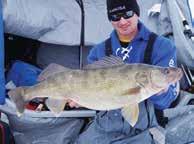
If you go, contact: Capt. Ross Robertson, bigwaterfishing.com, hogwalleye@yahoo.com, (419) 283-7069, www.facebook.com/BigwaterFishing/ www.instagram.com/bigwaterfishing/ www.youtube.com/user/Bigwaterfishing


Panfish anglers from all over the ice belt should have their sights set on Polk County, Wisconsin for some truly great panfishing! Picture a setting nestled up in the North Western woods of Wisconsin, out away from the metro where the only crowds present are that of big panfish. Big Round Lake and its surrounding smaller lakes offer an opportunity to ice your personal best Bluegill...the breed that features wide bodies and tall humps! The crappies are not to play second fiddle either. Each year there are several black crappies in that 14-16” range put topside, most of these big slabs come at dusk and into the night bite.
Polk County also features unique lodging and dining opportunities that offer true Northwoods appeal like the “Buckhorn Saloon”, home of Ice Junkies Outdoors” and “County Line Tavern” which offers some of the best food in the area! There are also several snowmobile trails and other winter activities always taking place in the area. n

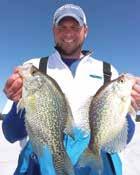

A hidden gem that lies right in the heart of the Black Hills is a body of water built in the 1940’s called Deerfield Reservoir. Because of the elevation at Deerfield, it is usually iced over in November, and hangs onto the ice until May. There are four main species to target: Rainbow Trout, Brook Trout, Perch, and Lake Trout. The rainbow trout are aggressive and abundant, ranging anywhere from 12”-16”. The Perch are the most-commonly found fish in the lake, with the average size around 9”, but the occasional 14”-15” does show up, just to keep us coming back for more. The not so abundant species are the brook trout and lake trout. The brookies run in the smaller size range, but what they lack in size, they make up for in beauty. And lastly, the Lake Trout, Although the rarest of all to catch, they are probably the most memorable. Averaging in the 6-8-pound range, you make no mistake when you hook into one of those.
Deerfield is also home to one of the largest kid’s ice fishing events held throughout the ice belt, called Hooked on Hardwater. Hooked on Hardwater brings in 60 professional ice fishermen and women from across the country for two days and pairs them with underprivileged boys from the Rapid City Club for Boys. n
For more information on Hooked on Hardwater, search The Club for Boys Hooked on Hardwater on Facebook, or go to www.theclubforboys.org/support/hooked-on-hardwater/


New Hampshire’s lakes region is one of the most sought-after ice fishing destinations in all of New England, with Lake Winnipesaukee being the center piece. Many of New Hampshire’s larger lakes are all situated within minutes of one another. Most Lakes Region lakes are considered two-tiered fisheries, meaning they can support both coldwater and warmwater species. Lake Winnipesaukee, Winnisquam, Big Squam, and Little Squam Lake all hold lake trout, trophy rainbow trout, and eelpout. Several Lakes Region lakes hold landlocked Atlantic salmon, but those fish are off limits during the winter months. You can also find jumbo crappies, world record-class white perch, huge bluegills and pumpkinseeds, and jumbo yellow perch in some areas. If the quality and diversity of fishing doesn’t’ get you, the view of the White Mountains to the north will.
If you go, contact: Tim Moore of Tim Moore Outdoors
Cell: 603-842-3572
www.TimMooreOutdoors.com
www.Facebook.com/timmooreoutdoors
www.YouTube.com/timmooreoutdoors
Just a few hours northwest of Minneapolis, it makes Lake Osakis a top destination for great ice fishing. The lake is 11 miles long and provides endless opportunities for Walleye, Northern Pike and some of the best Sunfish and Crappie fishing in the state. The lake boasts a very healthy Crappie population with strong natural reproduction, making this a great crappie lake year after year. The sunfish population is healthy and makes for great table fare as well. Head of the Lakes Resort offers cabin accommodations in the winter as well as fish house rentals. The resort also has a plowed road system with a donation box at their access. Make sure to pack your most-sensitive rod with a spring bobber or noodle tip, you will need the sensitivity as the bite can be very light. The Dave Genz Drop-Kick and the Clam Pinhead Minnow tipped with Maki Plastics or Euro Larvae will provide you the best success. n
If you go, contact: Scott Merwin, Lake Osakis Guide Service
www.lakeosakisguide.com
Possibly the greatest whitefish fishery on the planet. The arrival of quagga mussels and round gobies to Green Bay has pushed millions of whitefish onto the near-shore reefs and shoreline within easy reach of ice anglers. Practice your jigging cadences and steer clear of the crowds for easy limits of these tasty whitefish.
Supplementing the whitefish bite, Green Bay’s perch and pike fisheries have rebounded nicely in recent years and walleye numbers are at all-time highs. Late ice offers grand slam potential for whitefish, perch, pike and double-digit walleye. Bring the family along on your next Green Bay ice fishing adventure and take in the natural wonders of Door County, including spectacular ice caves, sledding hills, first-class state parks and trails, along with a full range of lodging and restaurant options. n
If you go, contact: Capt Bret Alexander (920) 851-4214 www.icefishgreenbay.com



If I had to choose one lake to ice fish in the West Metro (Twin Cities) area it would be Lake Minnetonka. The lake has much to offer an ice angler. Vast numbers of fish as well as a wide variety of fish species. My favorite being the crappie. If you are a hard-core angler that likes to search for fish there’s plenty of area to do that, and if you are a weekend angler there’s tons of community spots that hold good fish as well. After fishing, there’s plenty of good restaurants and breweries around the lake. If you are in the west metro make sure to check out lake Minnetonka. n
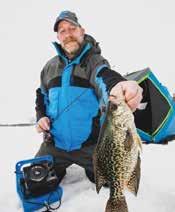
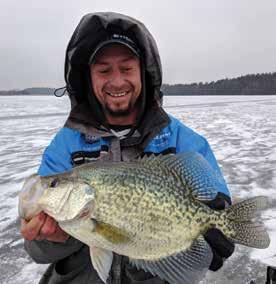


If you go, contact: Adam Griffith, Griffith Outdoors Guide Service gri2205@yahoo.com, (952) 913-8130
Snapchat: shwhisperer60
Instagram: gri2205
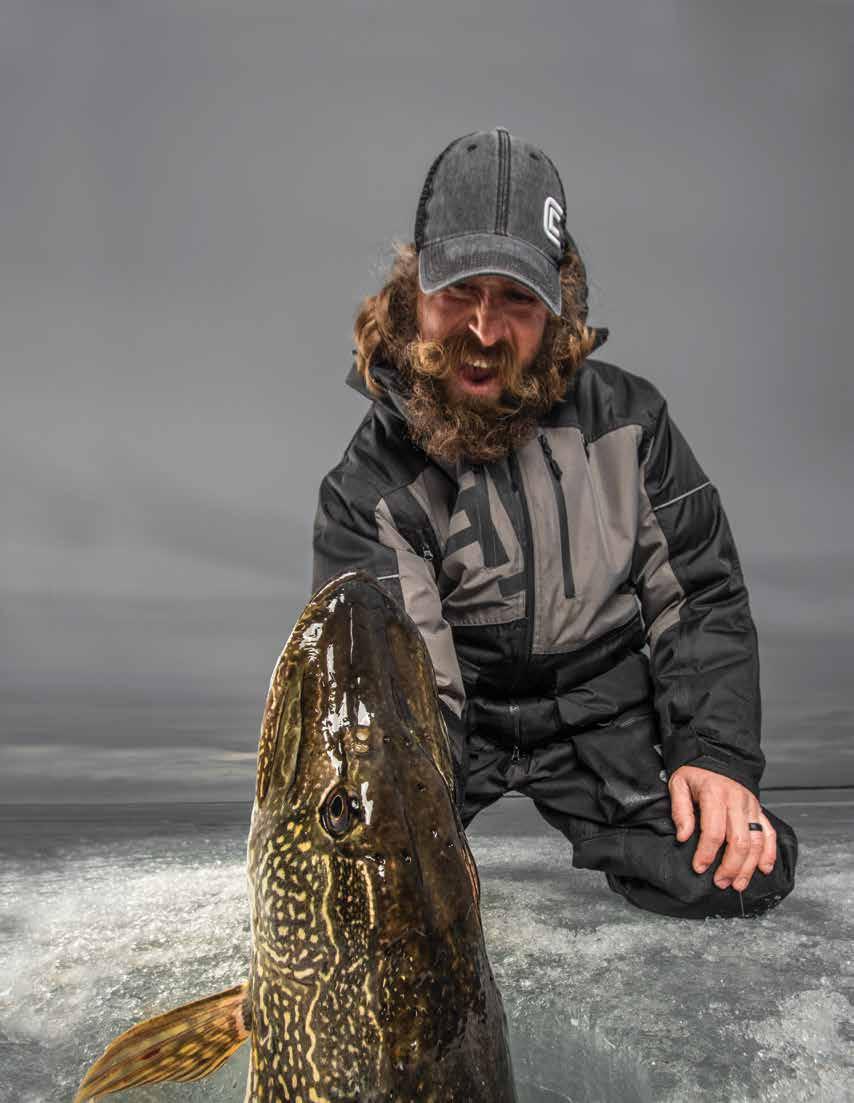
Finally, the last sleeper is tucked away in its summer sleeping spot. I walk into the garage and grab my bucket of tip-ups and head down to the river, Bostic or Fourmile to see who’s chasing flags today. It’s a remembrance to my days of walking around the streets of International Falls, going from 8th Street Rink to Kerry Park, to Carson Lupie, looking for the game to have some fun slapping around an old hockey puck. I guess you could say it brings me back in mindset, I wish my body could do the same sometimes, but without the journey traveled our adventures would just be fiction. As I reflect on this correlation, it cements my being so at home on the ice.
The beginning to the middle of March is usually when the time for chasing flags has come for this modern-day French voyageur. At this time of the year the snow on the lake has started to disappear and what is left is the smooth or rough formations that the freezeup gave us early that season. Even though I don’t wear them, I highly recommend wearing some sort of cleat for the bottom of your boots. People ask me all the time, why I don’t have them on, but recommend them so adamantly. Well the reason is, I’m so used to being on the ice from childhood to adulthood that I feel more comfortable without them, but my mother says I’ve also been hit in the head a few times.
Here’s a few of my personal preferences that I have gained through personal experience, while tip-up fishing on Lake of the Woods. I’ve fished out of 8”, 9” and 10” holes, but prefer a 10” hole. I’ve
used many different brand name tip-ups, but the Clam Thermal Tipups are filling my 6-gallon Clam buckets these days. I’ve used quickstrike rigs of all different brands but prefer the Bigtooth Zero Rig
(better hooking percentage and less chance of the hooks catching the bottom of the hole). I primarily use frozen Smelt and Alewives, but I also like to use a live sucker, a frozen Tullibee, and heck yeah, I’ve even

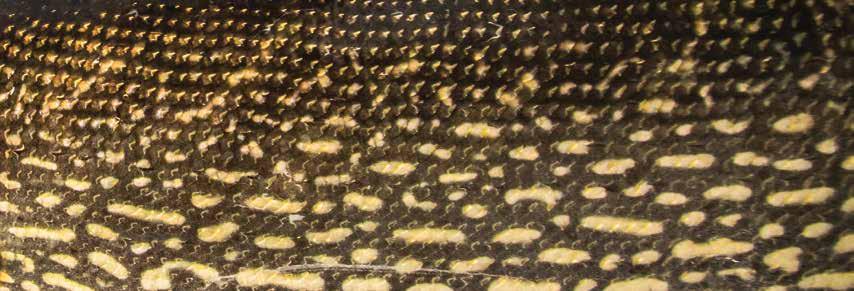
tried a Johnsonville Brat. The Pike will let you know what they want to eat, when they want to eat it, so be prepared to have a few different baits on hand.
For the last 7 years I’ve had the pleasure to chase flags and battle giant Lake of the Woods Pike with my great friend Jeff “Jiggy” Andersen. From our first adventure I’ve learned to shut-up, watch, listen and learn from a seasoned veteran pike hunter.

Thinking back at my tip-up fishing ability from before meeting Jeff, to today, it is as great a difference as day is to night. I remember the first time dealing with blowing wind



and having to make barriers with piles of snow creating halfmoons to slow the accumulation of snow over our tip-ups. I remember the first time punching through the ice
 Tip-ups are a great way to spend a day on the lake amongst friends.
Clam Trophy Thermal Tip-Up
Tip-ups are a great way to spend a day on the lake amongst friends.
Clam Trophy Thermal Tip-Up
and having the auger coming up with weeds on it and saying, let’s just try this spot. I remember the first time using the “pike pole” to get a pike lose from the bottom of the hole. I remember the first time drilling a hole and checking the depth, thinking to myself, this is way too deep, or way too shallow, only to catch the biggest fish of the day out of that hole. I remember the day we ran to every flag and we should have walked and vice-versa. I remember the first time we used a Johnsonville bratwurst to catch a giant pike. I remember the first times, could go on and on and on, but without a great friend to show me the way I would have never been able to experience this many first.





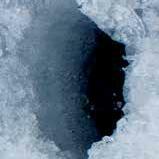

Chasing flags with great friends can help you get out of your comfort zone to learn a few new things about yourself and the hardwater. Jeff and I have been on some great adventures together, and through those adventures a bond was built, it is undeniable that chasing flags helped build that bond.


When you have a conversation with Dave Genz, it’s immediately evident that he’s insightful, honest and humble. Though Mr. Genz has been a key innovator in what is the modern era of ice fishing, he’s not an arrogant braggart of his accomplishments, but rather a constant creator, dreamer, and active listener. Why? Because even at 73 years old, Dave Genz is still on the cusp of great ideas that will continue to impact other anglers’ fish catching success.
What could the future of ice fishing look like? Genz has a few predictions. Yet to fully appreciate the innovations and advances we have today and could have tomorrow, we first need to revisit ice fishing’s transformation from the past.
Q: What were your first ice fishing adventures like?
Genz: I was very young when I first remember ice fishing, single digits in age. My dad was a road construction worker and he’d have time to ice fish in the winter. I was the youngest of four siblings and though sometimes my brother or sometimes my uncle would ice fish with us, our early ice trips were during deer season and everyone else was hunting, so it was just dad and I. My dad had quit deer hunting, which used to be the week of Thanksgiving, so instead we’d go ice fishing. I remember trips to Lake Carlos when we couldn’t get out to where we wanted to fish so we’d go to smaller lakes. Back then, sometimes we caught fish and sometimes we didn’t.
I’d watch as my dad would check the ice with a chisel. It’s something that’s stuck with me throughout life.
A young Dave Genz shows off a walleye caught in a shiner minnow, kahle hook and sinker. “We hadn’t started to use jigging yet”, reflects Genz.
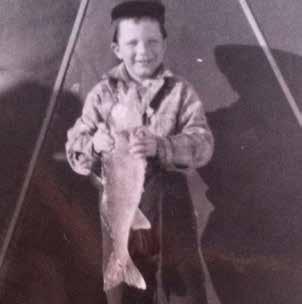
He would walk and hit the ice with every step. His brother was a blacksmith for the quarry in St. Cloud so we had a heavy duty chisel and when I was young, we only chopped holes.
As the ice became thicker, we would go to Mille Lacs Lake because we were walleye fisherman when the ice got safer. We always wanted to go out to the flats, but there were always ice ridges we had to cross over. The Morningstar resort on Mille Lacs (1950’s) had a
Bottom: From left to right, Patsy Genz (Dave’s wife), Arnold Genz (Dave’s dad) and Dave Genz with some Lake Melissa walleyes.

“We never threw fish back in those days exhausted it was good for the family.”
car with the body taken off, so it was just the frame, two bumpers and a front seat that had two metal drums on the front bumper and two on the back bumper so if the vehicle broke through the ice, it would float. It pulled a sled made of 2x12’s with supports and seats to
sit on that they’d tow behind with chains on the tires, since it was two wheel drive. To find our fishing spot, we would visually line up the fire tower in Garrison with a cabin, and Indian point would line up with a gap on the shore to find the trail for navigation. That’s where we fished. Eventually we’d put out a permanent fish house that was heavy, constructed of plywood. We’d drop a lead weight (clip on depth finder) down the hole to feel what the bottom of the lake was like and it was easy tell the consistency. If it was rock, you could feel it and we’d always set up the fish house next to the edge of the rock reef. All we fished with at the time was a number 4 kahle hook, a shiner and a few sinkers. We weren’t jigging for fish yet, so lively minnows were essential for consistent catches. We’d sometimes go to different bait shops because they had fresher, more active minnows.
My dad and friends would play cards in the permanent shelter, but as I got older I would take the chisel outside and chop new holes, searching for fish. My dad would tie it to my wrist so I didn’t lose the chisel down a hole.
I don’t remember the exact size of the fish we caught, but we didn’t throw any back. You were fishing for your limit and the size didn’t matter, because you were fishing for food. I never knew the exact size of the fish because my dad would never go to the bar to show the fish off.
Genz: Back then the walleye season closed around February 15 and since there’s a lot of winter left, we would fish for bluegills from that point on. When we’d chop holes, my dad would always tell me to chisel the hole wider at the bottom, otherwise they tend to naturally narrow like a funnel. Many times we would
Advances in technology, clothing and mobility over the years have helped anglers catch more and bigger fish. Dave Genz has some predictions about what the future of ice fishing might look like.
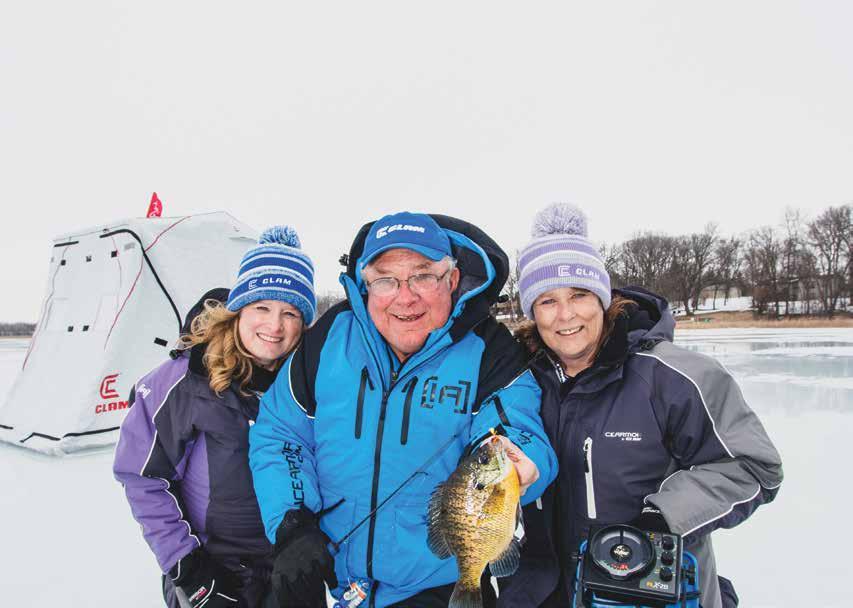
reopen that hole on numerous trips, because it was easier to chip a few inches of ice off the top than start an entire new hole, especially when there was a couple feet of ice.
The big invention for the time was the spoon hand auger. When we used the chisel, you didn’t fish that many holes. With the spoon auger, you could drill so many more. That’s when I started to realize that mobility was key, a new hole was a new opportunity! To me, drilling holes through the ice is like making a cast in open water and anglers cast numerous times to a general area, not just once.
Swedish augers eventually helped us drill holes with more efficiency because of integrated flightings and an offset handle. Now we were more mobile and able to drill more holes, which definitely influenced how many fish we caught. Then the power auger came out. That one item is still responsible for more fish being
caught than even electronics, because ultimately you first need a hole in the ice to fish, with or without electronics.
The first ice electronics I had was a Lowrance Green Box. I bought the unit at Holiday sports, but the intention was to use it during the summertime. My dad and I drove around Lake Melissa all day just to see what the depth was and where the drop-offs were. My dad was very interested to see an accurate layout of the lake.
When winter arrived, I thought the Green Box would work for ice fishing. They had a transducer cord that came out the top of the transducer, so I just dropped it in the ice hole. But the unit didn’t have much power, and though you could see fish, you couldn’t see your bait. So we would mark fish, then measure the fishing line by arm length to set our bait at the right depth.
Then Humminbird came out with the Super 30 that I got from Ted Capra who was the sales representative. I used a trolling motor transducer attached the end of a broomstick,
but I could still only see fish, until one day everything was set just right and I could see my jig. I knew that would change everything.
Ted Capra then became the Si-Tex rep and with the Fl-8 unit, which was later reintroduced by Vexilar, you could see your hook on the flasher. That’s when a major breakthrough took place.
Genz: Today, side imagery is a huge innovation. Being able to scan around the area to see where the fish are or the structure sits allows you to drill your holes more efficiently, but I seldom use side imaging for actual fishing. Your Vexilar provides so much information in real time so you immediately know how fish are reacting to your bait. The new digital formats provide ultra-clear readouts that you can easily see in direct sunlight and with numerous advanced features.
Today’s cold weather clothing has
become more comfortable and form fitting so you can use your physical abilities more productively. I used to wear flight boots with sheep skin lining and wool pants thick with insulation. The clothing was so heavy that I joke that it’s why I’m so short, because the clothes were so heavy. Now the clothing not only protects you from the elements, but is comfortable. People can stay out in harsh elements for longer periods of time.
Obviously the modern Fish Trap’s and hub style shelters keep anglers warm and out the wind, rain and snow, but also prevents others from realizing you’re catching fish.
Q: What are you most excited about for this upcoming ice fishing season?
Genz: Last year we made the trip to Lake Cascade with a lot of friends, and this year we’ve considered traveling east. In the early part of my career explored that portion of the ice belt a lot. My goal is to ice fish in 26 states, to have done so in over half the states. I’d like to achieve that.
Q: What do you predict ice fishing will look like in the next 60 years?
Genz: I dream that we will have the technology to make drilling holes even easier. As anglers age, that’s something that you could sell a million of instantly. Is it possible to have a laser cut a hole? That could potentially happen.
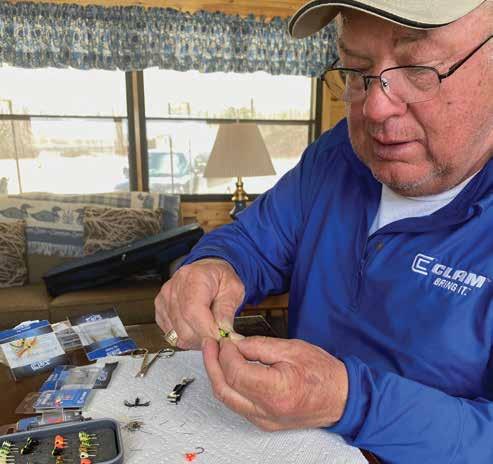
I think ice houses will continue to become lighter, easier to move around and even faster to set up.
An electronic bite indicator, either incorporated into the rod or the electronics would help a lot of anglers. Some people still have difficulty figuring out if they have a bite. When graphite rods came out being able to see a bite AND feel the bite was huge. But until you have the proper set up, you don’t get both. That comes with high quality equipment, but there’s no replacement for time on the water.
No matter what you want to get better at, time is the formula. If you want to golf better, golf more. If you want to become a better angler, fish more. You have my permission. n
For decades, legendary ice fisherman Dave Genz has influenced the products and techniques ice anglers utilize and continually innovates to this day.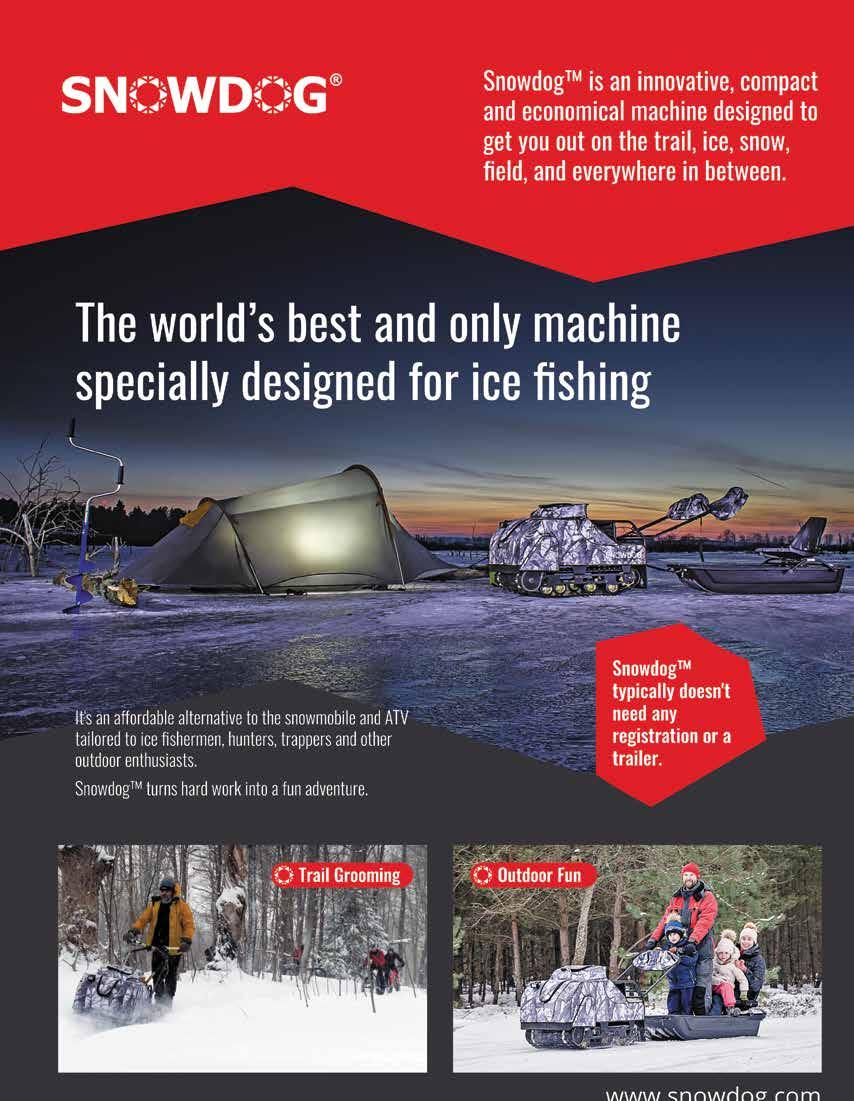
Anytime you deal with a fish that retains memories and lives to an age of over 100, you
must be creative to get bites. Flying into remote fisheries where Lake Trout have never seen a person, boat, and have never seen a fishing lure can be like catching bluegill as a kid: extremely aggressive and easy. Well...that is not what this article is about.
Colorado Lake Trout are the complete opposite. Every single fish I encounter has seen every tube jig and traditional bait ever manufactured. They know the routine. If you have a good jigging cadence, can identify the bite, and set the hook you will catch a decent fish out of every few you encounter on a good day. However, if you are that angler that strives for excellence, that wants big fish (and lots of them) then you must think outside the box. To get these fish excited and have them positively react to your presentation you need a new bait or move the bait in a non-traditional manner.

Let’s start off with what you need to know. Lake Trout are a large eating machine. They NEED to consume a lot of food! An average 40” healthy Colorado Lake Trout will consume 3 to 5 fish a day ranging from 10” to 14” in size. I always encourage
anglers to think about this as they drop down a 4” tube jig expecting results. These fish want to eat so give them a meal.
Step One- Big or Small... There is a time and place for both big and small presentations. Being that the average meal size of the fish I’m targeting is 12” I almost always go with a larger lure when targeting these fish simply to give them a meal, appear worth the energy to eat. So, I attempt to use bulky, larger baits. Essentially, they match the hatch. Secondly, these baits are highly visible in size and therefore easy for the Lake Trout to see and find from quite a distance in our clearer waters.
On the opposite end of the spectrum, when you see Lake Trout absolutely stacked up and highly gathered on a small piece of structure downsizing to a small spoon to imitate a minnow or forage
fish can be highly effective. The smaller presentations never seem to be large enough or appealing enough to draw fish in from a distance, but you did that work by finding them in this situation. Within the realm of smaller presentations spoons tend to be best as they cross over into a reaction bite.
Visual Effectiveness- In so many situations matching the hatch or having an exact match to a bait fish or fish they are feeding on can be so powerful. On the other hand, there are times that I want a presentation that looks like it’s from outer space, something off the wall that they have never seen. Anglers struggle with this concept but something “new” is exciting to a fish that has seen it all and exciting gets bit! When it comes to visual effectiveness it can be accomplished with color or style of bait. I have days or weeks when I’ve been pounding on fish with


a natural-colored bait and all the sudden the fish start to lose interest. Then I switch up to something crazy, even neon completely 180 from what I was using and bam, back on them! Sometimes this can be hard to do and a lot of anglers lack confidence but sometimes a no pattern is exactly what is needed.
If color is not the answer, then style of bait comes next. Probably the biggest thing that I have done in the past couple years he’s taking a concept and then simply tweaking it. For example, I started off the season fishing traditional tube jigs like normal but after a week the fish started to shade away. I kept the concept of a weight forward head and tentacle tails but instead of sticking to a tube jig I went to large saltwater squid-style teaser. Again, just a tweak on a traditional pattern and the effectiveness was unbelievable! Visual changes on the extreme can drastically increase your success on pressured fish.
Finally, is movement. In so many presentations you find yourself doing the same traditional short hops and
tight line falls. If the traditional is not working you need to change it up. Again, you can go to both sides of the spectrum. My goal is to make the lakers think, “What is going on here? That is odd, I better kill it.”
One quick change is to jig for 15 seconds and then let it sit totally still for 30 seconds. You can dead stick like that suspended or even lay it on bottom. That lack of movement can often cause confusion and trigger a bite. On the far side of the spectrum everyone does the same slow cadence trying to emphasize their feel on the bait so they can make the most of a hook set. The opposite
is, of course, being extremely aggressive to the point where you try to play keep-away from the fish. Pounding bottom to kick up dirt and then ripping it away from the fish and taking it away and going up and down in the water column making them chase it works more than you think. Think deeper, extreme movement will always be a realistic situation of fearful prey in the presence of a predator. The second a lake trout sees its prey getting nervous and trying to swim away to avoid it, the predator instinct to hunt it down kicks in. So many anglers lack the confidence to rip their bait away from a potential trophy fish but once you get the confidence to do so the result will blow your mind.
At the end of the day, an angler’s mindset on thinking about the situation and thinking outside the box will hands-down produce more success than anything else. You must get in your head that these fish are educated and have seen everything. It is strictly a mind game in producing bites but once you get in their head you have them! n

My goal is to make the lakers think, “What is going on here? That is odd, I better kill it.”


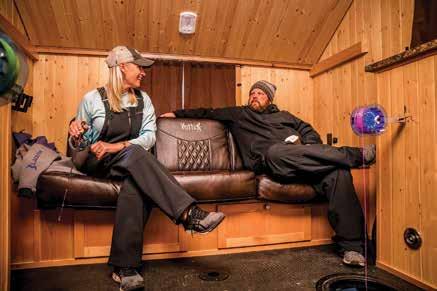
Sometimes I’ll decelerate the lure drop speed to the strike window even more by feathering the line between my thumb and forefinger. This becomes an attractor as does simply ticking the rod tip or spring bobber. At time, even pauses or motionless lure action can become a trigger.
Monstrous sunfish select and study their food sources. Any unusual bait movement, noise, or abrupt weather fronts will affect the bite during winter or open water. As anglers, it is mandatory under these circumstances that we evaluate lure color, bait profile, jig motion, rod action, and line diameter, then adjust accordingly to interest the fish and draw strikes.
To help weave through these many factors, allow me to introduce a specific technique I call sight-lining. It’s not complicated, but our fishing line can provide visual cues that will dramatically improve the allimportant strike-to-hookset ratio.
Let’s begin with the tools. Two-pound-test clear or green color monofilament line creates a slower entry into the water column because of its larger diameter (compared to braid or fluorocarbon) and it’s less sensitive, which produces a natural feel for fish, too. Always blend line color with water clarity. An ultralight, soft-tip 19- to 26-inch rod with a balanced spinning reel allows you to position your line and lure directly over the center of the hole.
I consider that rod recommendation practically mandatory for my hard water panfishing! Use shorter rods in flip-over-style houses and longer rods in wheel houses.
I find that a No. 12 or 14 ice lure tipped with one or two larvae fished in 20- to 40-foot-plus depths is most productive. Patience is required here to accommodate the slow descent in the water column. And avoid using split shots! Your line and lure must balance with each other to prevent slack and memory. That allows us to sense the micro flick or even a “gut feel” that a fish is at the first stage of mouthing our bait.
As for sight-lining technique, hold the rod parallel to your body to observe any slight line movement. There is a quarter-second window before a fish expels the bait, sometimes even much less. Set the hook firm “cross their eyes” prior to entering fish’s mouth. You’ll see the hook in the upper bony part of the mouth if you’re hook-setting correctly.
This is the reason why sight-lining is so effective way beyond the simple tick or thump feel in the rod itself.
Sunfish can’t stand a potential food source dangling in front of their eyes! Either interest and a strike will happen, or fish will ignore a poor presentation. Hold the rod perfectly steady while cupping the reel with your hand. Consider placing the rod on your leg to eliminate any rod activity in case your hand can’t hold it steady. If conditions demand subtle bait movement, employ your forefinger on the rod blank in front of reel and apply down and up pressure.
Over jigging will spook sunnies, so allow no more than one minute to coax a fish. After that, don’t waste time: Work another fish. When your Vexilar displays a red band or the band increases in width covering your bait, set the hook.

Never forget: There is no charge for hooksets!
Experiment with a slow drop-andstop or raise-and-stop within entire water column from 6 inches above the substrate. Dismantle the idea fish strictly are 2 to 3 feet from the bottom. Aggressive jigging will many times draw fish back into your locator’s cone angle. In other words, don’t be in such a hurry to move. This strategy requires one rod and one hole combined with confidence and concentration. n
Fish talk to anglers, and sightlining provides a whole new tool in interpreting their language!
Read more from “Tackle” Terry Tuma in Oudtoor News or at www. outdoornews.com
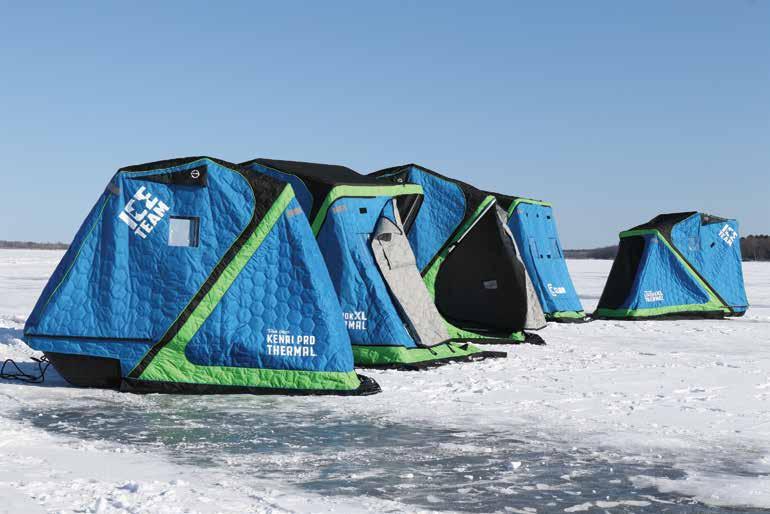






























Spending a day on the ice can be taxing on your gear and your body, so fuel up ahead of time and plan ahead to ensure a day of fishing success.
Ice anglers are masters of preparation but preparing isn’t just your gear or where you will fish. On a typical night before our group heads out, we prep our gear charging Vexilar batteries, cordless drill and underwater camera batteries, or filling up the gas auger. It is important to begin each day with your equipment fully charged and fueled. So why not take care of your own body in the same way? Fuel up and pack some grub to keep you sharp while reeling fish through the ice.
Hydration and fueling the body should not be taken lightly; anglers need our energy just as much as our Vexilar’s need to be recharged. My biggest problem is not bringing something to drink and during a day of walking and drilling while looking for the next trophy, you would not believe how much moisture you lose through respiration, not just perspiration and sweating. People associate dehydration with summer when you are hot and thirsty, but it happens yearround if you’re not keeping your body hydrated. It’s much easier to reach for a cold drink on a hot summer day rather than when you are standing on a frozen lake, but you still need to get your fluids. You can pack waters, sports drinks, coffee, soup…hot or cold, plan to grab something to drink on the ice just like you’d grab your jig box.
Recognize the signs of dehydration. This can help you remember to drink more water and stay hydrated. Thirst, dry mouth, dark-colored urine, dizziness, fatigue, and dry skin can all indicate dehydration and who has not woken up in the middle of the night howling with a leg cramp? These are all signs your body needs water, and
often it’s better to preventively drink water so you aren’t running into any of those annoying symptoms. For an adult male like me, it is recommended to drink nearly 128 ounces of water a day. Some of that water comes in food, but others just need to come from a drink throughout the day. That’s a gallon of water daily!
Packing a snack or a meal is fun and easy. Why settle for gas station tuna salad when you have Mother Nature’s refrigerator on hand? Pack a few fruits and vegetables. Not only are fruits and vegetables good for you, but they also help you stay hydrated. During the latter part of the ice season as the days grow longer, I like to bring the grill for those 12+ hour days on the ice plus it breaks up the middle of the day when the fish are having a siesta. Johnsonville sausage and grillers are a go-to item on the stainless-steel propane tabletop grill that has 222 sq inches and 12,000 btu for cooking on the coldest of days. Trust me when I tell you that some grills don’t have the BTU’S to warm your hands when the wind is blowing from the north and it is single digits out! I like to pre-make
1/2-pound burgers or double up on the Johnsonville’s to save space on the grill (feed more people) and save time to get back to fishing. I like to follow a hot lunch with a cookie or brownie before return for the afternoon/evening bite. The sky is the limit on how creative you want to get when throwing down some grub for you buddies on the ice and even if the fishing is slow, they will appreciate the meal you provided. Sometimes a little food break is perfect for perking up morale and keeping things fun.
Just keep in mind if its easy you will do it and make it fun. There’s nothing like having a few fishing friends gather around for a different type of hot bite and some drinks. Always remember to have a trash bag along to haul out your trash; being a steward means setting a good example and on occasion, picking up after others.
If you’ve forgone food for ice fishing, left your water bottle at home or in the truck too often, or been guilty of gas station food grabs, make the change to healthier options and plan ahead. You’ll feel better, fish better, and have more fun. Fuel up your body on your next ice fishing trip. n
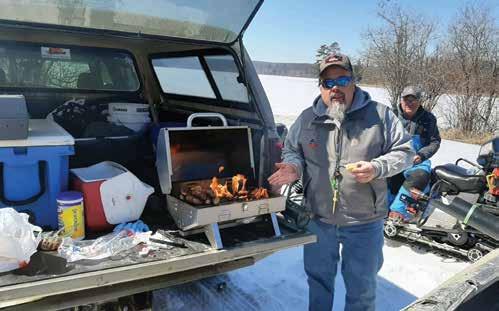

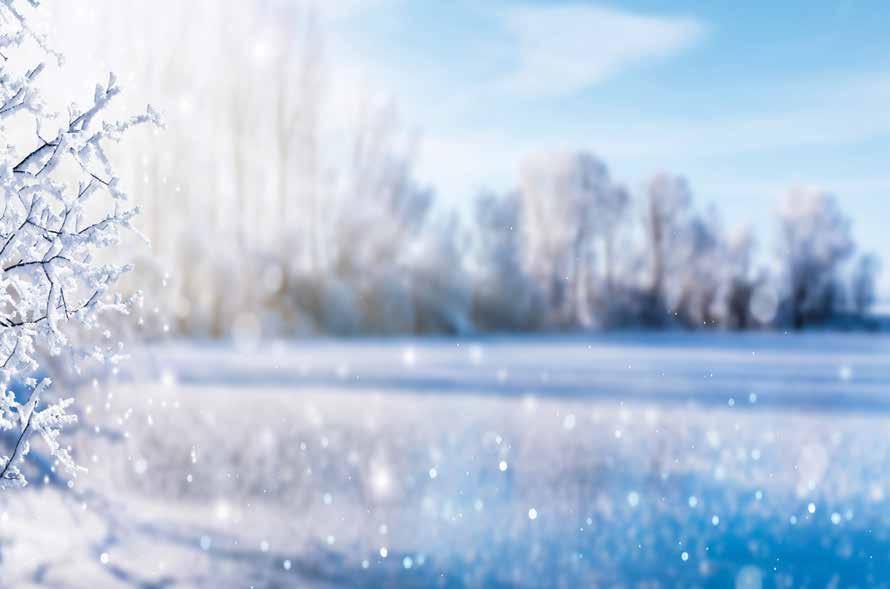








 By Chuck Mason
By Chuck Mason
When something “SHINES” it means that it works really well, and that can apply to ice fishing when it comes to the art of deadsticking walleye. The term applies basically to any type of rod presentation where you are not actively holding the rod in your hand. It is a great way for anglers to add another rod to the fishing trip while jigging a rod, and either placing it outside, or when there is room, inside your shanty as well. Here are three times during the day when a deadstick will be most effective and unlike some articles you read, these tips will work on any type of lake you might fish.
Morning bites are typically the time of the day when walleye are most actively feeding. Throw in that evening bite and you have the same type of situation. They want food, and they want it now, or how they say, “The bite turned on.” The fish will slam a spoon or chase a swimming minnow up the water column before they engulf it. You can put just about anything down the hole and it is game on. Typically I will be jigging two rods
while swimming. Here I will play with Clam Outdoors’ tungsten Drop
TG Jig in either 1/8, 3/16 or 1/4 oz, depending on the body of water. Do not overlook the Drop XXL jig on
times calls for going old school, in this case, it is hook and sinker time. You can run a #10 treble hook, but I prefer something less obtrusive. My next decision is the size of the egg or
shine and be big apart of your future presentations! n
Chuck Mason Michigan Ice Team Pro

The author, Jason Mitchell with a big bluegill. Across the ice belt, big bluegill are one of ice fishing’s most sought after prizes. Catching big bluegill is no easy task. Many lakes that have the capability to produce big bluegill are difficult to fish by design.

Big bluegills are a precious and coveted resource that just never seem to lose their appeal. There are not many fish that will get ice anglers as genuinely excited as a big bull-nosed gill. Not every lake or fishery has the capability of producing top end fish but what always surprises me is the variety of lake types or river systems that can produce big fish. We have filmed big bluegills from shallow reclamation lakes in northern Iowa to stock ponds in western South Dakota. In our travels, we have experienced fishing for extremely quality fish in just about every region you can combine bluegill and ice.
River backwaters on the Mississippi River produce big gills. Some trophy gill lakes are unassuming lakes in the Minnesota Northwoods while other opportunities are simply the result of some type of factor that can buffer fishing pressure. Large lakes like Minnesota’s Leech Lake or some of the other big lakes have just have enough water where some of the larger fish can elude anglers over the year. Some flowages like the Mendota Chain offer some large shallow basins that become weed choked during the summer. Shallow lakes that often see algae blooms and choke up with weeds often just get ignored or are difficult enough to fish during the summer where some of the bluegills can live long enough to get big.
Anglers are also becoming more conservation minded with selective harvest and a growing catch and release ethic for the larger fish. This change in angler attitude is a long time coming. For years, we would release a big musky or a big walleye while collectively thinking nothing of filling a bucket full of big bluegill. Ice anglers are starting to realize however that a ten-inch bluegill is as rare and as old as a twenty-nine-inch walleye.
The real key to catching big bluegill is simply fishing where they live. Identify water that has big bluegill potential and put in the time. The biggest bluegill are seldom easy. The reality is that a small, easy to fish lake that is full of eager, big bluegill is usually private in today’s world. On public water, there has to be some type of factor that makes the fishing
more difficult so that fish can grow big and die of old age. There are hard to access options like some river backwaters where poor ice can make some areas difficult to reach. There could be a small, unassuming lake in a public forest with no boat ramp and a long, winding portage that requires a snowmobile. Could be a large body of water where the sheer size is a protective buffer against angling. Might be a trending lake that simply winter killed three years ago and the fish that survived have less competition for food and the lake has had a poor reputation because of the winterkill so the result is fewer fish
These fertile fisheries however can also be just difficult enough to fish in the winter where many anglers simply get frustrated. Shallow dish bowl lakes or flowages often create challenging bites because the fish spook easily and when the water clears up, these fish get a very good look at the presentation. The best big bluegill fisheries typically have some factors that make fish tough to catch by default.
Besides fishing where big bluegill live, remember that even on the best fisheries… there usually isn’t enormous schools of big fish. Often, we are fishing for one fish at a time. The presentation has to be perfect. If there is any turn or spin on your jig, you are not getting bit. If you can’t find the exact quiver or dance on the jig that the fish want, a big bluegill will often put on the brakes. If the knot isn’t perfect and the jig isn’t centered or straight, you are not getting bit. Shuffle your feet and the fish scatter. These types of fisheries often require you to slow down because you push fish away every time you make a move. You have to settle down in good spots and let the fish come back to you.
Genz designed and perfected the Clam Silkie which is a must have in every bluegill an gler’s arsenal. The Silkie is very subtle and durable, perfectly replicating back swimmers and other insects that bluegill eat.
growing faster with much less angling pressure. There is usually some degree of difficulty when it comes to finding and catching big gills.

Another factor that we are seeing emerge time and time again is clear water conditions that are simply difficult to fish. Where catching fish is a hair pulling endeavor. Environments that are clear and shallow often produce some enormous bluegill for a few reasons. These clear, shallow environments often get weed choked in the summer with intense algae blooms that stifle angling pressure during the summer not to mention offer fish plenty of places to hide.
To catch big bluegill, anglers find that they often need to be much more detail orientated. Plastics have to be hooked perfectly symmetrical and straight. The action to trigger a strike is often delicate. Dropping down to one- or two-pound monofilament can give the jig the most delicate quiver but only if the plastics or bait is hooked perfectly. The best presentations will still breath life even as they hang still.
We saw the popularity of tungsten and soft plastics explode over the past decade. In conjunction with today’s electronics, ice anglers have taken these aggressive presentations and applied an aggressive mentality for finding fish. There has been a common mantra lately… go big or go home. Fish heavy, fish fast and be the first person to land on a particular pod of fish. The first person to land on fresh fish is realistically going to encounter aggressive fish. We saw panfish anglers leaning towards larger profile soft plastics that can be seen from further away. This mentality has
Incorporate finesse into your bluegill fishing this winter. When using one or two-pound Frost Mono on smaller horizontal jigs, try a snell knot so that the jig hangs horizontal whenever the eyelets are too small to tie a Palomer knot. Pictured is a size ten Drop Jig with a Silkie tied with a snell knot.

been deadly effective for not only breaking down water and finding fish but also elevating some of the largest fish in a school higher in the water column.
There is a yin to the yang however and in our travels across several States fishing several different fisheries each winter, we can honestly say that finesse is making a big comeback. Not that finesse ever went away… at least in places. There are many premier bluegill fisheries where we always had to drop down to finesse to catch fish. Also, interesting to note that finesse is old. If you were to look at many of the very best anglers on the ice, say thirty years ago that had a knack for catching big bluegill, most of them were slinging two-pound high vis Stren on a plastic spooler reel and the business end consisted of a tear drop with a crushed wax worm.
Maybe there are factors that are bringing finesse tactics back into the main fold that we can see. We have better water quality and invasive species like zebra mussels are cleaning up the water tremendously. Also seeing more anglers on the ice. Every ice angler these days has a contour map uploaded onto their smart phone or a standalone GPS. Most anglers are using electronics. Aggressive presentations still find fish but finesse is the perfect compliment. Slow down and scrutinize the presentation. You can take a size 10
Drop Jig and make that jig look and fish a lot of different ways by what type of line that you use, what knot you use, the knot placement, type of plastic or bait is used and most importantly, how the plastic or bait is hooked. You will catch more fish if the bait or jig can be presented very delicately. If you can get the jig to quiver or dance with very delicate movements when the jig is hanging still, you will usually catch more fish. Spend a lot of time watching the jig in the hole. Spend a lot of time managing your line so that you can impart the most delicate movements without the jig turning or twisting.
I used to hate using one- or twopound monofilament and joked that I only dropped down to that light of line when I absolutely had to. The Frost Mono changed that thinking for me because the line is so easy to manage and is durable. I seldom snap fish off on a hookset and find that I can fish through the day with the same line. When dropping down to horizontal jigs that are smaller than a size 10, use a snell know to tie jigs as the small eyelets will make a traditional Palomar knot difficult to tie and the snell knot will hang the horizontal jig horizontal without having to ever adjust the knot.
To get the most delicate quiver or action on the jig, nothing in my opinion beats a crushed waxworm. Simply hook the wax worm on to the jig so that the waxworm is hanging
off the jig perfectly straight and symmetrical. Pinch the wax worm so that all the juices come out and watch the wax worm in the water. The skin of the wax worm body should be able to flap and flop up and down. If fish are more aggressive, great soft plastic options include the Maki Polli and Spiki. I also use the Silkie with great success. The Silkie is one of Genz’s brain children and is a small rubber ball with silk strands. I often rig the Silkie so that the strands come forward toward the head of the jig with other strands coming back out towards the hook. The Silkie is extremely durable and subtle. I often trim the strands with a scissors when targeting bluegill but you can customize the Silkie a lot of different ways and use the Silkie in conjunction with live bait or soft plastics. These are all tools to have in the toolbox.
What we have seen over the past twenty years is an explosion of ice fishing popularity with aggressive search and destroy trends becoming very popular and effective for ice anglers. In our travels and with all the ice anglers we have conversations with each winter, we hear a common theme and that is how many ice anglers no longer use anything but soft plastics. We hear how ice anglers move and move. That all works extremely well but there is a tipping point. When all the ice anglers start fishing the same way, I find that it pays to start doing something different. Focus on water that is more difficult to access or fish. Add wrinkles to your presentation so that you are extremely efficient. Aggressive presentations are very efficient for covering water and finding aggressive fish but at the end of the day, finesse is very efficient at simply catching or triggering each red mark that swims underneath you. Learn to use finesse and incorporate finesse into your arsenal of presentations.
Also, on a side note while discussing the topic of catching big bluegill, I would dare say that on about eighty percent of the water we fish… about eighty percent of the biggest fish we see are caught within an hour of sunset. Take that observation for what it is worth n


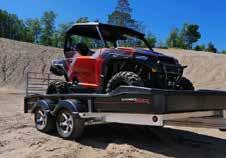


New this year and one of the hottest panfish baits around. It is great fished alone on a bait or tip it with a few euro larva/spikes, wax worm or adding Maki plastic with the Silkie works awesome, my favorite Maki is a 1” Mino white with red flakes or a red is good also.

Most of the time it will catch fish all by itself. The silk like strands just float around in the water with little jigging motion.







It is very easy to install on the hook just put your hook through the rubber ball in the center and slide it all the way to the head of the hook. I will also rotate it in the up and down position, so the top silk covers the hook.

Two of my favorite jigs are the Clam drop kick and the Drop jig rigged with a Silke. Red glow and Gold are two of my favorite colors. I have been having good luck with the Black in color and White/Red combo.
My thought is the fish think the Silkies look like the nature microorganisms, water bugs, back swimmers that are swimming around in the waters.
I have caught blue gills, crappies, bass and pike on these so far this year. Next on the agenda is to try to see if I can get walleyes to bite on them. Stay tuned on this.
The durability of the Silkie is outstanding I can catch 40-50 or more fish on one Silkie itself.
If I forgot my live bait at home, I would still go on my fishing trip without it as I am very confident in the Silkie for catching fish.
Safe Fishing, Scott Seibert



Dave is known as “Mr. Ice Fishing” and is credited for leading us into the modern era of ice fishing. Without Dave, ice fishing wouldn’t be where it is today. Dave has influenced most of the ice fishing designs and concepts we use every time we hit the ice, most notably Clam’s Fish Trap shelters. www.davegenz.com
Matt is a professional fishing guide and the owner of North Country Guides and Promotions. Matt’s versatility on the ice has allowed him to consistently catch trophy fish in all species. He also appears in many publications, both cited and as an author.

www.northcountryguides.com
Terry is a member of the National Freshwater and Minnesota Fishing halls of fame. “Tackle”
Terry Tuma reaches thousands of anglers every year via seminars and outdoors TV.


Tuma also appears on multiple radio stations. Read his popular weekly fishing blog at www.outdoornews.com/minnesota


Tony Mariotti is a knowledgeable promotional fisherman from the lakes country of Minnesota. Tony is willing to share the most current local tips, tricks and conditions — making him an elite educator in the sport of ice fishing.



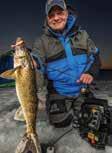



Scott is a fishing guide and promoter who travels the ice belt educating anglers. www.lakeosakisguide.com
Jeff is a professional fishing guide and the co-owner of Andersen Brothers Outdoors. Jeff appears regularly on various TV shows and in magazines and is an accredited multi-species angler.
www.andersenbrothersoutdoors.com
Shelly is a professional angler and promoter who has been teaching others how to ice fish for years. A regular seminar speaker, Shelly excels at relaying her fishing knowledge to others. She’s always smiling and willing to lend a helping hand.
www.sksguides.com
Jason is a professional fishing guide and a national fishing educator. Jason is sought out as one of the best teachers in the sport of fishing. He has also written many publications on freshwater fishing. www.go-fish-guides.com
JP’s first memory is fishing with his father and grandfather on Rainy Lake at age three. During hard water, JP works out of Baudette and runs a Sleeper Ice Fishing business, along with portable ice fishing shelters.
www.lakeofthewoodsoutdoorsman.com
Chris is an accomplished ice fishing guide on Rainy Lake in Northern Minnesota. He truly enjoys educating others and ensuring that they have a great time on the ice.
Scott is a professional fishing guide and a leader in outdoor promotions. Scott is one of the original Ice Team Pros and has several ice fishing tournament wins under his belt. Scott spends a lot of time mentoring the youth of our sport. www.sksguides.com
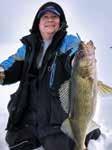

www.rainydazeoutdoors.com
Pat is a fishing promoter and educator with a focus on bringing new anglers into the sport and having fun.
Mike is a fishing guide and promoter who spends a lot of time chasing the big fish of Mille Lacs Lake.



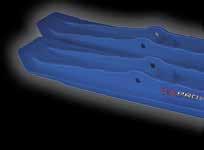
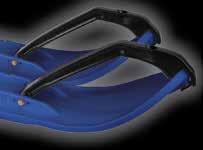






Matt is one of the hosts of “Crappie Chronicles” and chases down big slabs wherever he goes. He’s also an accom plished winter tourna ment angler.
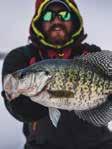
Adam is one of the hosts of “Crappie Chronicles” and guides across the Metro Area, MN. He’s also an accomplished winter tournament angler.
Ryan is the owner of Ice Junkies and spends a lot of time guiding and targeting big panfish in Western Wisconsin.



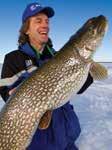

Keith is a professional walleye angler and a co-host of “Next Bite TV.” Keith is a Legendary Angler inductee into the National Fresh Water Fishing Hall of Fame and has been featured in about every major fishing publication in existence. www.thenextbite.com
Tommy grew up fishing and boating on Lake Superior. It was always a dream of Tommy’s to be a fishing guide/captain. He enjoys getting clients on the ice/water and teaching them not only how to be successful, but to do it safely. www.beyondthecatch.com

Eric is a professional angler, guide and educator who spends most of his time chasing only big fish in the harbors and bays of Lake Michigan. You can also find him on a hot bite throughout various inland waters, as well. www.wibigfish.com
Bret is a well-known guide in the Green Bay area, where he targets big fish of all species. It’s not uncommon to see him cited in many publications, as well as TV programs.
Gary is a professional walleye angler and a co-host of “Next Bite TV.” Gary is the only person to have won Angler of the Year titles in three open professional walleye circuits and is arguably one of the best walleye anglers on the planet. www.thenextbite.com
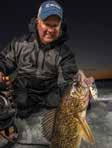

Pete is a professional angler and appears regularly on TV programs such-as John Gillespie’s Waters and Woods. Pete is one of North America’s top authorities on muskie and pike and is known around the world for these accomplishments. www.petemaina.com
Jim is a professional angler and promoter. Jim frequents the competitive ice fishing scene where he is an established, top tournament angler. He also appears as the kids’ instructor for most of the events in which he participates.
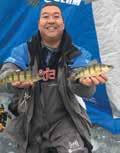


Chuck is a professional angler and guide. He is also a well-known on-ice tournament angler who has many championship appearances under his belt.


Chase is a professional walleye angler and a cohost of “Next Bite TV.” Chase maintains the title as the youngest full-time walleye angler in the world and consistently earns top finishes throughout the walleye circuits.
www.thenextbite.com
Barb is the President and founder of Wisconsin Women Fish and the Woman Ice Angler Project.
www.podcastgarden. com/podcast/ thegreatwildradioshow
Pat is an accomplished guide and promoter who hails from the Sheboygan, Wisconsin area. He is also co-owner of the famous Wolfpack Guide Service and has traveled the ice belt to help ice anglers learn about the great sport of ice fishing!
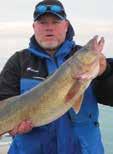
Jon is a professional guide who spends his time on Lake Gogebic. Jon is known for monster perch, with numerous fish over 2-pounds caught every year and his style of fishing is second-tonone. www.fishwithguy.com


Mark has earned a place as one of the most well-known tournament walleye anglers of all time. Winning multiple highlevel tournaments, Mark has taken that drive into the educational world where he conducts onice schools across the Midwest.
Zippy is a professional fishing guide and the founder of the famous Perch Patrol guide service out on Devils Lake. Zippy spends just about every day on the ice and brings unmatched on-ice experience to the team. www.perchpatrol.com

Kevan is a professional fishing guide and promoter. Kevan spends a lot of time giving seminars and targeting fish across the expansive array of Iowa’s glacial lakes. Watch for Kevan on TV, sharing his knowledge with the ice fishing world.
www.paulsfishingguide.com
Rod Woten - Iowa
Rod Woten is a professional ice angler and accomplished on-ice tournament angler from Iowa. Rod has many top finishes in tournaments across the ice belt and has fished in most states where ice fishing is available.




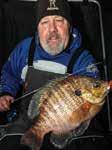


www.coldwaterguideservice.com
Tim is a professional fishing guide and outdoor promoter. Tim chases just about every species that swims and he constantly shares his secrets. Tim continues to blaze new ground and has a ton of exciting winter stories.
Craig is a professional guide and promoter in the Black Hills and western part of South Dakota: everything from inland trout, to panfish, to monster pike. Craig also travels the ice belt and you’ll see him at most ice fishing events promoting the sport he loves. www.iceaholicsanonymous.com
Dennis is a professional angler and promoter. Dennis has spent countless hours chasing fish across Minnesota and South Dakota. His knack for fishing a wide array of lake types makes him one of the more versatile ice anglers in the game today.
Scott is a professional angler and owner of Maki Plastics. Scott spends a lot of time traveling the ice belt promoting the great sport of ice fishing. It’s not uncommon to see an appearance from Scott at most ice fishing venues. www.makiplastic.com
Jason is a professional angler and guide who also hosts the “Jason Mitchell Outdoors” tele vision show. Jason has established himself by guiding in the summer along with the famous Perch Patrol on Devils Lake in the winter.

www.jasonmitchelloutdoors.com
Tod is a professional ice angler and promoter. Tod has competed in several top ice fishing tournaments with outstanding results. You can also expect to see Tod appear on several different TV segments across Illinois.
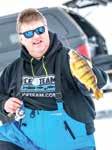
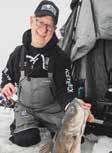
Don’s roots go back to the beginning of Ice Team as a fishing partner to Dave Genz when in Nebraska. Don has some of the largest panfish at his fingertips and you’ll smile when you hear his reports and see his pictures.

Nate is a professional fishing guide and ice fishing school instructor. Nate is the owner of Tightline Outdoors, where he not only offers year-round guide trips but also caters to the largest on-ice school in Colorado.
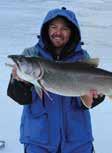

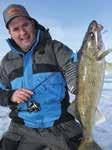
James is a professional fishing guide and promoter. He is one of the go-to on-ice talents in the Eastern part of the U.S. and is responsible for leading a lot of the efforts in that area.
www.fishhoundsoutdoors.com
Ross is a professional angler and educator. Having written many articles — and now books — Ross has become one of the country’s top-authorities on big-water walleye. Ross spends a lot of time on Lake Erie and brings a lot of skills that he’s always willing to share.
www.bigwaterfishing.com
Mike Howe is an accomplished fishing guide and tournament angler. Whether he’s targeting giant lake trout or conducting onice perch tournaments, Mike dedicates himself toward growing the sport of ice fishing and passing his knowledge on to others.
The most convenient way to ensure your tailbone won’t meet that hellaciously hard ice, just strap the Apex Ice Cleat on, grab your auger and start punching holes knowing there’s no ice condition these babies can’t sink their teeth into.






20 MULTI-DIRECTIONAL,











Matt Cornell - Manitoba
Matt is an accomplished fishing guide who hails from Winnipeg, Manitoba, and chases big fish of all species. You’ll oftentimes see him hoisting giant “greenback” walleyes from the famous waters of Lake Winnipeg.
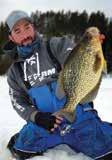
Brandon is a professional guide who knows what big walleyes look like. He spends most of his time on the Bay of Quinte where he enjoys providing others with that “once in a lifetime” experience of landing a truly monster walleye.
Rob “RJ” Jackson is a prolific multi-species angling expert and guide. He regularly targets everything that his home area of Eastern Ontario has to offer including panfish, smallmouth and largemouth bass, pike, muskie, carp, gar, various trout and salmon. www.rjnbirdeesoutdooradventures.ca


Ryan Salemi - WI
One item I won’t leave home without is my Rise Suit float suit from Ice Armor by Clam.
Terry Tuma – MN
My Vexilar. Hands-down.
Tony Mariotti – MN
Won’t leave home without my flasher. I don’t care what type of sonar you are using, once I get set up I rely on my flasher to show me the mood of the fish and it’s reaction to my techniques.
Craig Oyler – SD
Vexilar, don’t want to waste time fishing in an area where there aren’t any fish. A Vexilar will tell me that.
Ross Robertson – OH
Would not be without my electronics.
Jason Mitchell – ND
If there is one item I don’t want to leave behind, that would be a Vexilar. I can hope to borrow a rod or tackle but have a real hard time fishing without being able to see my presentation and how fish respond.
Chris Granrud – MN
I’d say the one thing I would struggle leaving behind is my electronics. From contour map reading
to my eyes underwater, electronics are the single most valuable tool in the chest.
James Vladyka – VT
Can’t leave home without the electronics. That just makes for a long day of fishing with a blindfold on.
Dennis Kassube – SD
My Vexilar for sure. As Dave Genz would say I won’t leave home without it! I always have an extra one in my side by side or pickup just in case. Although more than once I’ve had people borrow the extra, never have I ever had one of my Vexilar’s not work.
Brandon Ouellette – ON
One thing to always have is a compass. Electronics fail, fuses blow, batteries die, and squalls can block GPS.
Pat Kalmerton – WI
Hands-down my Blackfish Gear Gale soft shell. Allows warmth, comfort, and flexibility for an extended day on the ice.
Jason Durham – MN
The one thing I never leave at home when heading ice fishing is an extra pair of gloves or mitts. Both are notorious for disappearing without
a trace, so having extras in a pocket or even in the vehicle can be the difference between “comfortable” and “miserable”.
Mark Martin – MI
My Ice Armor by Clam suit is my second shanty as I walk around teaching students on the ice, a must have.
Bret Alexander – WI
The one thing I wouldn’t leave home without would be a positive fish catching attitude!!
Jim Kusuda – WI
The one piece of equipment that is with me is my Clam Drill Plate with the extension. I like the way the curved blades of the conversion kit shave the ice quickly and smooth!
Matt Breuer – MN
Comfortable, warm clothes and accessories. There’s nothing worse than forgetting gloves and having frozen hands. I won’t leave home unless I know that I’ll be comfortable on the ice.
Kevan Paul – IA
Besides all the stuff that you must have like good gear and electronics, I will not leave home without my Ice Armor Gloves. I’m not getting any under and
my fingers need to work to catch fish. Make sure you own good gloves. They will help you fill your bucket.
Scott Brauer – NY
The one thing I won’t leave home without, is information. Do your research on where you are going and what you are fishing for. Look for reports on what is biting, what the fish are eating and where they are at that time of the year.
My 32” Dead Meat rod... it’s sensitive tip allows to detect the most scuttle bites, yet it’s backbone holds up to the mightiest fish Lake of the Woods has to offer.
Tim Moore – NH
There are several things I don’t leave home without when heading out to go ice fishing, but near the top of that list is my Ascent or Rise suit. Staying comfortable keeps me efficient and allows me to be more mobile.
Jeff Andersen – MN
GPS for me is a tool that is something that I use every single time I’m fishing. Map contours and history of locations allows me to truly understand structure and fish positioning. n
We live fast-paced lives. Everything is go, go, go. Speed is often considered something of importance, whether it’s in reference to sports, completing tasks, get to and from locations, and even productivity on the ice. How fast can you move from spot to spot, how fast can you drill a series of holes, or whatever the objective. However, it’s time for an abrupt stop. A halt on your fishing tendencies. It’s time to relax and focus—because it will help you catch more fish.
How and why exactly will slowing down, relaxing, breathing, help you catch more fish? Well, we play into the mood of the fish, and we give ourselves time to focus on the details of the catch. Why do you think a golfer takes a moment to channel their focus before making a shot? Or what about a pool player? They do this so they can make the best shot, to make sure they don’t make mistakes, and ultimately to achieve the best outcome and to be successful. This way of thinking can easily be applied to ice fishing, especially when it comes to the battle between you and the fish.
So, just how do we implement a little relaxation and focus into ice fishing? Well, we do it by slowing down and paying attention. We fine-tune our approach when dropping a lure down to the fish. We swim the lure more than we “hop” the lure when the situation calls for it. We pay attention to subtle changes in line movement, absence of weight, changes in jigging sequence, and any unexpected wiggles of the spring bobber. We train ourselves to notice the little things,
because we allow ourselves to slow down, relax and focus.
A great way to do this is to start using spooler style reels if you haven’t already. I prefer the ones where you need to still pull the line out by hand, rather than pushing a lever or button and the lure drops quickly down to the fish. I like stripping the line by hand because it allows me to 100% control the speed at which the lure falls to the fish. I can now force myself to slow down and focus, and as importantly— work the entire water column. It’s amazing how many fish we miss because we “bomb” the lure down the fish. We see that red mark on our Vexilar and we shoot it straight down, only to miss the potential of a better opportunity on the way down if we just took a little more time.
You also want to focus on slower movements while jigging. Now, I’m not huge on doing nothing (deadstick approach) when it comes to ice fishing. I understand there are certainly situations that call for it, but I’d rather just drastically slow down my sequence rather than do nothing. It’s amazing how fast and aggressive we like to move the lure under the ice. I can’t imagine that the fish don’t get headaches trying to keep up with the movements that we present below the ice. Slowing down—but not stopping—will give you the best of both worlds and can sometimes be the single-most change that it takes to catch more fish. Swim the lure and make it glide or quiver. Lose the quick hops, darts and shakes. Sure, when the bite is aggressive, they will crush it, but oftentimes we find ourselves dealing
with negative or neutral fish while ice fishing. Slow down and focus on the movements of your lure to properly entice the fish.

Pay closer attention to your Vexilar—it tells us a lot more than we think. Watch what the fish do in reaction to what you do. Pay attention to what works and what doesn’t, how quick the fish shy’s away from a jigging sequence or how interested it becomes. Make mental notes of the wins and losses. Duplicate the successes and change the rejections. Don’t go insane (which be definition can mean to repeat something over and over knowing you’ll get the same negative result). Your Vexilar is your fish’s mood indicator. Rely on it and learn from it. Slowly work the lure away from the fish, even if it seems interested. Then watch your line, spring bobber or rod tip as the fish closes in. Feel for absence of weight. This is where slowing down and focusing can make you a better ice angler. Use the tools to your advantage.
The bottom line here is that we can all relax a little. We can all slow down and focus on the smaller details and adjustments that need to be made. We can leave the fast-paced life for when we’re off the ice—at least when we’re in battle with the fish. Run-andgun to find the fish and locate the school, but then take a moment to breathe and slow down when it’s time to engage with those marks on your Vexilar. You’ll be surprised how a little bit of concentration can turn into big rewards. Here’s to a little bit of R&R and a lot more fish! n
